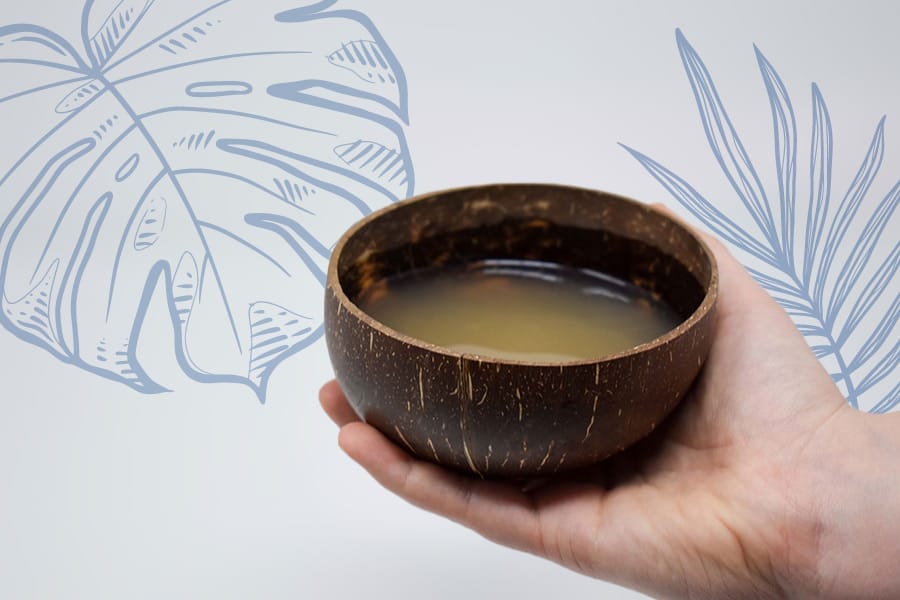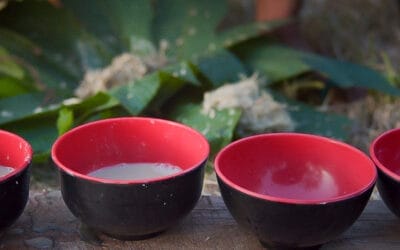
An iconic image of relaxation is sinking into a lounge chair on a beach with a coconut shell cup in one hand, sipping on a delicious beverage as you gaze at the sunset. Sounds like paradise, right? Well, while we can’t deliver an ocean view to your doorstep, we can offer you vessels for relaxation: coconut cups, or, as they’re known in the Pacific Islands, bilos. Let’s dig into the details of these amazing drinking vessels—bula!
What is a Bilo?
A bilo is half a coconut shell hollowed out, smoothed, and carved to form a cup. Authentic bilos are handmade and range in size and style depending on their island of origin. Many bilos are left unadorned, but some feature intricate designs that highlight the culture they come from. Most coconut cups hold about 4-6 oz of liquid per shell making them the perfect vessels for serving kava.
The common styles of coconut cups found in Vanuatu and Fiji are called bilos, but they go by other names depending on the region. In Hawaii, a coconut cup is called an apu, and awa, or kava, is served in an apu.
History: Coconut Cups for Kava
Serving kava in a coconut shell cup dates back centuries to the early ages of the Pacific Island cultures. Since ancient times, drinking kava has been part of significant ceremonial occasions, and bilos were used to serve kava during the proceedings. In many traditional kava ceremonies across the Pacific Islands, kava was prepared in a large wooden kava bowl called a tanoa and then served in a bilo. Usually, the first to receive the bilo would be the village chief or the highest-ranking individual at the ceremony. Then, the bilo would continue to pass through the group of people in descending order based on rank. To this day, kava ceremonies are used to honor visiting dignitaries. In fact, Prince Harry and Megan Markle sipped out of bilos in 2018 when a kava ceremony was held in their honor during a visit to Fiji.
Through the centuries, kava ceremonies and bilos started to be integrated into the celebrations marking everyday family and village life: births, weddings, anniversaries, and funerals. Nowadays, bilos aren’t only used in the Pacific Islands—they’re global! From kava bars to social gatherings to personal kitchen use, bilos are still enjoyed by kava community members across the world.
Bilo Cup Care
Bilos need gentle care and cleaning to make sure the integrity of the coconut cup is kept intact. We recommend hand washing your bilo and not letting it soak for long periods of time. Only use your bilo to serve beverages (like kava) at room temperature or cold. Extreme heat can cause the bilo to break, so avoid serving hot beverages in a bilo (use a mug for a hot cup of kava tea!). Most importantly, don’t put your bilo in the microwave, oven, refrigerator, or dishwasher. A dry, room temperature space is best to store your bilo in! Also, pro tip, if you want to keep your collection of coconut drinking cups polished, try rubbing the outside with a little coconut oil after washing and drying—you’ll love the shine!
Why Try Kava in a Bilo?
- To have an authentic kava experience
- To enhance your next kava party
- To give as a unique gift to a friend who also enjoys kava
If you’re ready to take your relaxation game to the next level (the island level), try one of our handmade bilos today! Our bilos are handmade in Fiji and Vanuatu and sourced directly from the islands, so you know you are getting an authentic relaxation experience with our bios.
Need some kava to fill your brand-new bilo? Buy kava online at Kalm with Kava today and select the kava variety that fits your relaxation needs the best. Enjoy your bilo of island bliss!


